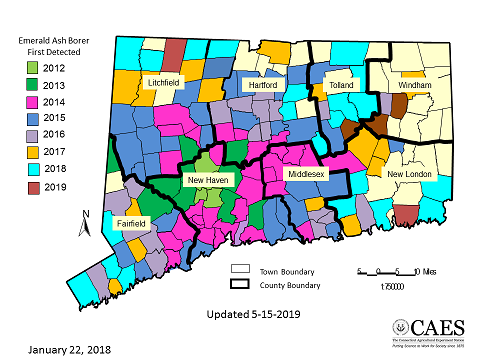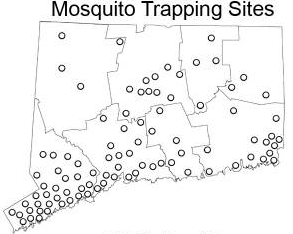Invasions

Asian Tiger Mosquitoes

The Asian tiger mosquito continues to expand its range northward as the climate warms.

The range of the Asian tiger mosquito is expanding in the United States, particularly into Connecticut and other northeastern states. Infection rates of West Nile Virus and other mosquito-borne diseases, such as Dengue and Zika, are likely to rise as a warming climate creates more favorable habitats for mosquitoes. Much of Connecticut is expected to get warmer and wetter over the coming century, enhancing mosquito populations by creating more suitable habitat.
The invasive Asian tiger mosquito, Aedes Albopictus, first appearance in the United States was in Texas in 1985 and was followed by rapid expansion. This mosquito was first discovered in Connecticut in 2006.
Scientists at the Connecticut Agricultural Experiment Station (CAES) published a study in 2017 that documents the recent statewide expansion. Another recent study projected a significant expansion of the Asian tiger mosquito's range under two climate change scenarios. The most expansion would occur in southern New England where this species is predicted to occupy most of Connecticut by 2039.
It is not just the expansion of suitable habitat that allows mosquitoes to thrive here. As the temperature rises, everything about the disease-spreading biology of mosquitoes speeds up. Warmer temperatures are more likely to make mosquitoes breed, get infected, and transmit disease at a faster rate. Warmer air incubates the virus faster in the cold-blooded mosquito. Warmer temperatures make the mosquito hungrier, so it bites more people.
Emerald Ash Borer
The emerald ash borer is an insect that is not native to North America. It was first found in 2002 in the vicinity of Detroit, MI and Windsor, ON. In 2012, Connecticut became the 16th state known to have emerald ash borer within its borders. Since 2012, the emerald ash borer has spread to 136 towns in all eight counties.

The emerald ash borer attacks ash trees almost exclusively. In Connecticut, ash trees make up just slightly less than three percent of the trees in the forest, most of which are white ash. The loss of ash trees from the forest, like the loss of any specific kind of tree, would lead to rippling effects on other organisms living in the woods. Butterflies and moths from nearly 30 different families live on ash trees. Seeds of ash are eaten by wood duck, bob white, purple finch, pine grosbeak and fox squirrels. The loss of ash trees in a forest stand also reduces vital habitat and allows undesirable invasive plants to fill the gap created.
Movement of ash, in particular as firewood, nursery stock, logs and wood packaging materials, has been cited as the most likely means by which emerald ash borer has spread so rapidly.
Additional information about the emerald ash borer in Connecticut can be found on this dedicated website or at www.emeraldashborer.info.
Technical Notes:
1) The Connecticut Agricultural Experiment Station collects mosquitoes from June through October at 91 trapping locations as part of the Connecticut Mosquito and Arbovirus Surveillance Program. In 2016, new sites were added to the surveillance network. The data in this indicator is restricted to the original 91 sites that have been in continuous operation for 20 years at CAES (shown below).
COMING SOON: Future editions of this report will document other invasive-species populations in Connecticut.







